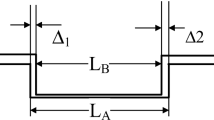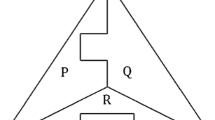Abstract
In the design activity, part geometry is assembled to create an assembly model. The number of parts may range from a few tens to a few million and typically the relationship among them constructs closed-loops with under-constrained states. In this paper, a 3D constraint solving method is proposed for closed-loop assemblies with under-constrained states. The proposed constraint solving method determines assembly configurations by applying the following procedures: 1. Transform the geometric mating relations into the kinematic joint relations, 2. Convert the closed-chain kinematic assembly to an open kinematic assembly by removing a joint, 3. Compute an open kinematic configuration by solving the open kinematic problem and 4. Obtain the closed-loop kinematic configuration by pasting the ‘cut’ links of the open assembly. The cut and paste operations minimise the number of constraint variables that have to be solved simultaneously. Thus, it can maximise the efficiency and robustness of an assembly constraint solver. The proposed constraint solving method combines the simplicity of a sequential solving approach with the universality of a simultaneous solving approach.






Similar content being viewed by others
References
Rajan VN, Lyons KW, Sreerangam R (1997) Generation of part degrees of freedom from assembly surface mating constraints. In: Proceedings of ASME design engineering technical conference, DETC97-DTM-3894, September 1997
Ambler AP, Popplestone RJ (1975) Inferring the positions of bodies from specified spatial relationships. Artif Intel 6:157–174
Rocheleau DN, Lee K (1987) System for interactive assembly modelling. Comput Aided Des 19(2):65–72
Whitney D, Mantripragada R, Adams J, Rhee S (1999) Designing assemblies. Res Eng Des 11(4):229–253
Anantha R, Kramer GA, Crawford RH (1996) Assembly modelling by geometric constraint satisfaction. Comput Aided Des 28(9):707–722
Kim J, Kim K, Choi K,Lee JY (2000) Solving 3D geometric constraints for assembly modelling. Int J Adv Manuf Technol 16(11):843–849
Kramer GA (1992) Solving geometric constraint system: a case study in kinematics. MIT Press, Cambridge
Oliver JH, Harangozo MJ (1992) Inference of link positions for planar closed-loop assemblies. Comput Aided Des 24(1):18–26
Craig JJ (1989) Introduction to robotics. Addison-Wesley, Reading
Wang LT, Chen CC (1991) A combined optimization method for solving the inverse kinematics problem of mechanical manipulators. IEEE Robot 7(4):489–499
Zhao J, Badler NI (1994) Inverse kinematics positioning using nonlinear programming for highly articulated figures. ACM T Graph 13(4):313–336
Parviz EN (1988) Computer-aided analysis of mechanical systems. Prentice Hall, NJ
Acknowledgements
This work was supported by grant number R05-2001-000-01412-0 by the Basic Research Program of Korea Science & Engineering Foundation.
Author information
Authors and Affiliations
Corresponding author
Rights and permissions
About this article
Cite this article
Kim, J.S., Kim, K.S., Lee, J.Y. et al. Solving 3D geometric constraints for closed-loop assemblies. Int J Adv Manuf Technol 23, 755–761 (2004). https://doi.org/10.1007/s00170-003-1686-y
Received:
Accepted:
Published:
Issue Date:
DOI: https://doi.org/10.1007/s00170-003-1686-y




